A&A Coffee: International Business & E-Commerce Market Evaluation
VerifiedAdded on 2023/06/15
|24
|7116
|433
Report
AI Summary
This report provides a comprehensive evaluation of international marketing opportunities, focusing on A&A Coffee's potential expansion into the Asia Pacific market. It identifies relevant Australian and international standards, policies, and guidelines affecting marketing, explores the role of e-commerce, and examines legislations impacting business operations. The report includes a detailed market evaluation report for A&A, assessing international business and e-commerce market factors, risk factors, and potential marketing opportunities. It also analyses trade patterns, e-commerce diffusion factors, and the impact of free trade agreements, concluding with insights into cost-benefit analysis and return on investment. Desklib provides this solved assignment and many other resources for students.
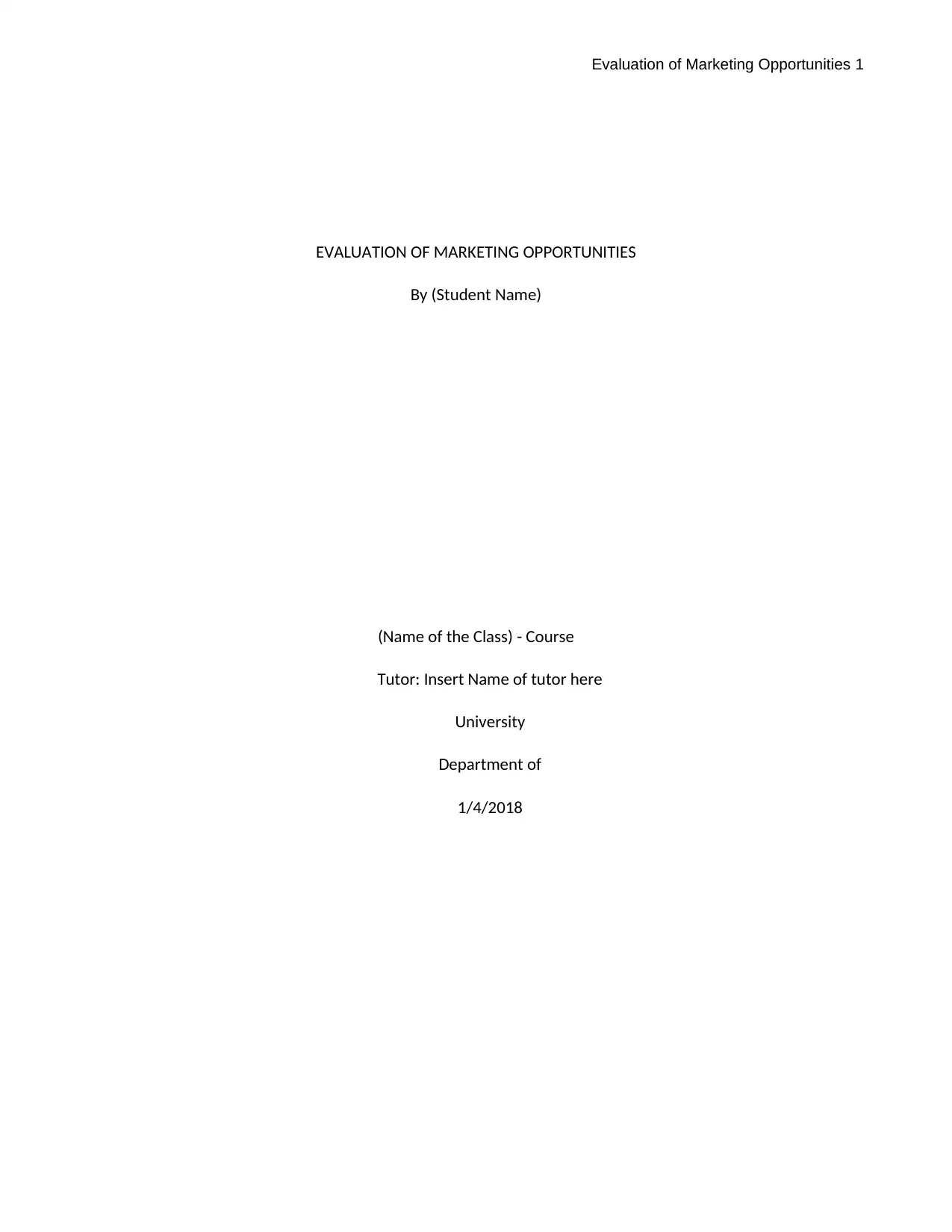
Evaluation of Marketing Opportunities 1
EVALUATION OF MARKETING OPPORTUNITIES
By (Student Name)
(Name of the Class) - Course
Tutor: Insert Name of tutor here
University
Department of
1/4/2018
EVALUATION OF MARKETING OPPORTUNITIES
By (Student Name)
(Name of the Class) - Course
Tutor: Insert Name of tutor here
University
Department of
1/4/2018
Paraphrase This Document
Need a fresh take? Get an instant paraphrase of this document with our AI Paraphraser
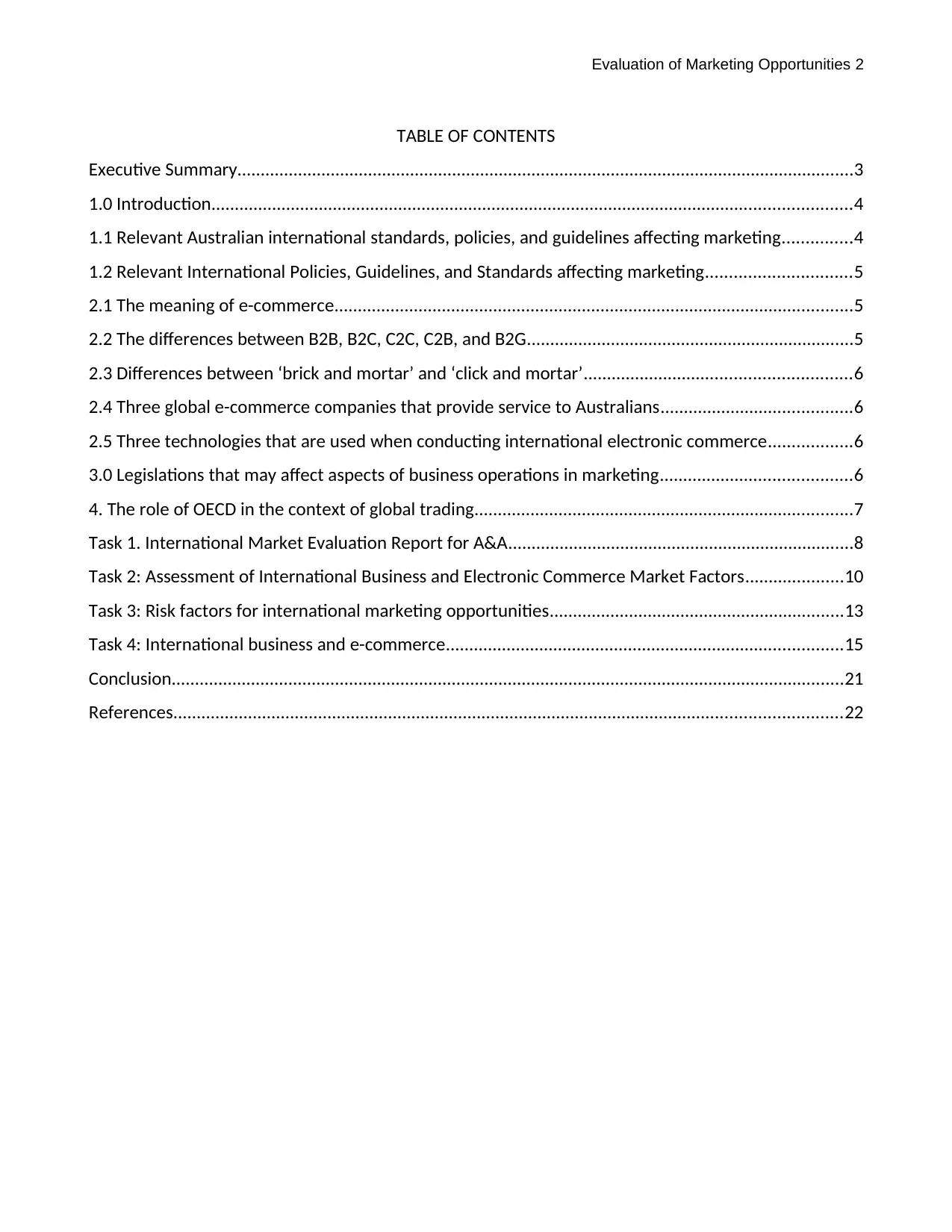
Evaluation of Marketing Opportunities 2
TABLE OF CONTENTS
Executive Summary....................................................................................................................................3
1.0 Introduction.........................................................................................................................................4
1.1 Relevant Australian international standards, policies, and guidelines affecting marketing...............4
1.2 Relevant International Policies, Guidelines, and Standards affecting marketing...............................5
2.1 The meaning of e-commerce...............................................................................................................5
2.2 The differences between B2B, B2C, C2C, C2B, and B2G......................................................................5
2.3 Differences between ‘brick and mortar’ and ‘click and mortar’.........................................................6
2.4 Three global e-commerce companies that provide service to Australians.........................................6
2.5 Three technologies that are used when conducting international electronic commerce..................6
3.0 Legislations that may affect aspects of business operations in marketing.........................................6
4. The role of OECD in the context of global trading.................................................................................7
Task 1. International Market Evaluation Report for A&A..........................................................................8
Task 2: Assessment of International Business and Electronic Commerce Market Factors.....................10
Task 3: Risk factors for international marketing opportunities...............................................................13
Task 4: International business and e-commerce.....................................................................................15
Conclusion................................................................................................................................................21
References...............................................................................................................................................22
TABLE OF CONTENTS
Executive Summary....................................................................................................................................3
1.0 Introduction.........................................................................................................................................4
1.1 Relevant Australian international standards, policies, and guidelines affecting marketing...............4
1.2 Relevant International Policies, Guidelines, and Standards affecting marketing...............................5
2.1 The meaning of e-commerce...............................................................................................................5
2.2 The differences between B2B, B2C, C2C, C2B, and B2G......................................................................5
2.3 Differences between ‘brick and mortar’ and ‘click and mortar’.........................................................6
2.4 Three global e-commerce companies that provide service to Australians.........................................6
2.5 Three technologies that are used when conducting international electronic commerce..................6
3.0 Legislations that may affect aspects of business operations in marketing.........................................6
4. The role of OECD in the context of global trading.................................................................................7
Task 1. International Market Evaluation Report for A&A..........................................................................8
Task 2: Assessment of International Business and Electronic Commerce Market Factors.....................10
Task 3: Risk factors for international marketing opportunities...............................................................13
Task 4: International business and e-commerce.....................................................................................15
Conclusion................................................................................................................................................21
References...............................................................................................................................................22
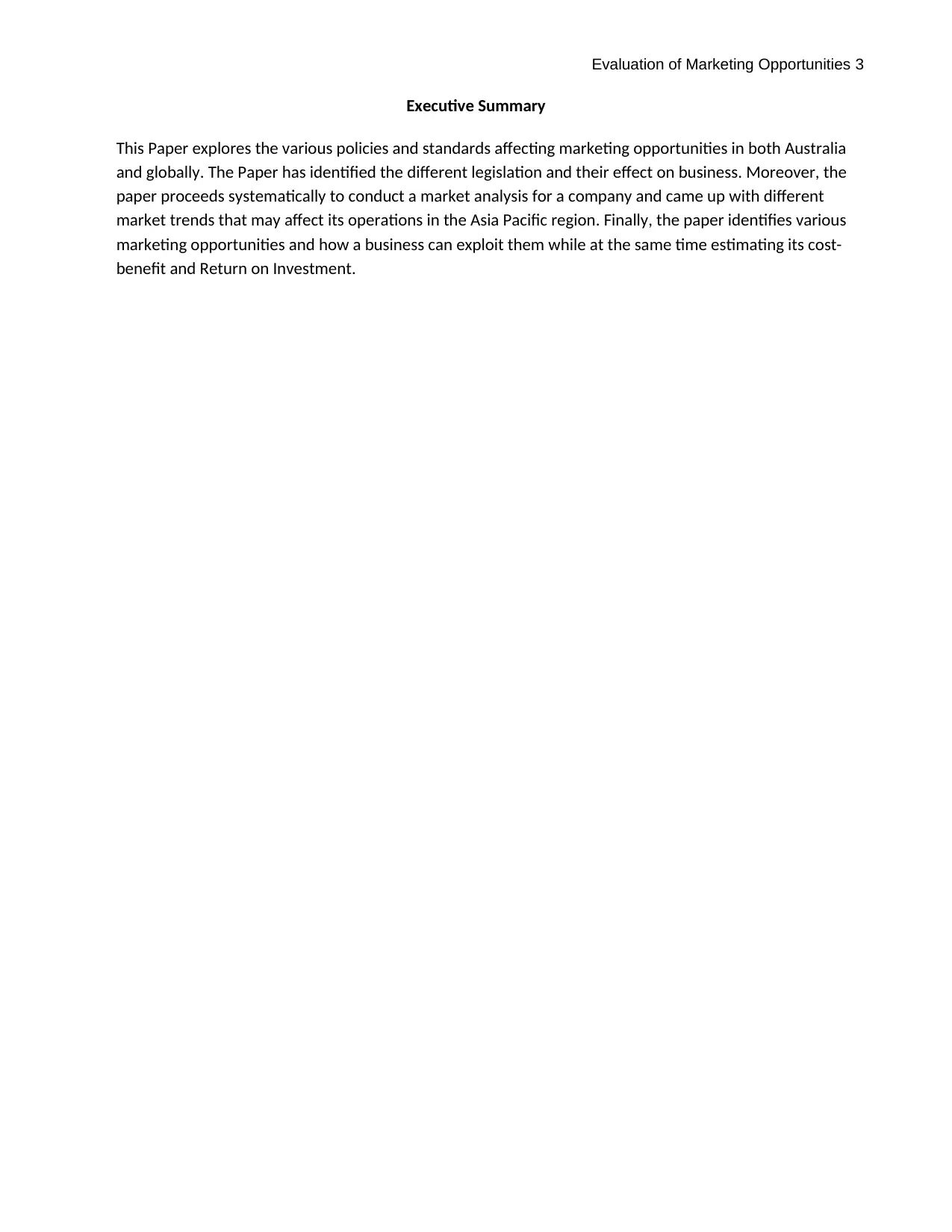
Evaluation of Marketing Opportunities 3
Executive Summary
This Paper explores the various policies and standards affecting marketing opportunities in both Australia
and globally. The Paper has identified the different legislation and their effect on business. Moreover, the
paper proceeds systematically to conduct a market analysis for a company and came up with different
market trends that may affect its operations in the Asia Pacific region. Finally, the paper identifies various
marketing opportunities and how a business can exploit them while at the same time estimating its cost-
benefit and Return on Investment.
Executive Summary
This Paper explores the various policies and standards affecting marketing opportunities in both Australia
and globally. The Paper has identified the different legislation and their effect on business. Moreover, the
paper proceeds systematically to conduct a market analysis for a company and came up with different
market trends that may affect its operations in the Asia Pacific region. Finally, the paper identifies various
marketing opportunities and how a business can exploit them while at the same time estimating its cost-
benefit and Return on Investment.
⊘ This is a preview!⊘
Do you want full access?
Subscribe today to unlock all pages.

Trusted by 1+ million students worldwide
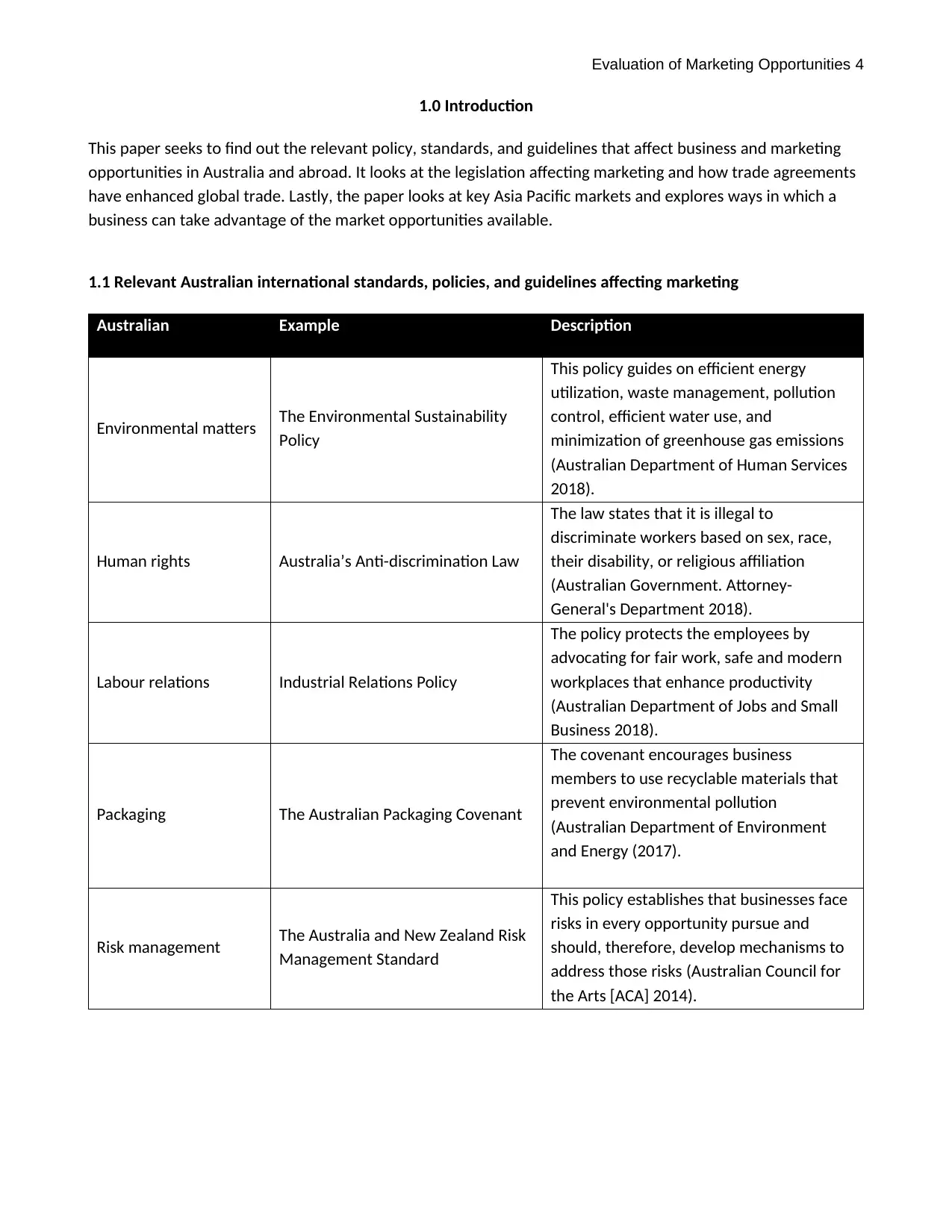
Evaluation of Marketing Opportunities 4
1.0 Introduction
This paper seeks to find out the relevant policy, standards, and guidelines that affect business and marketing
opportunities in Australia and abroad. It looks at the legislation affecting marketing and how trade agreements
have enhanced global trade. Lastly, the paper looks at key Asia Pacific markets and explores ways in which a
business can take advantage of the market opportunities available.
1.1 Relevant Australian international standards, policies, and guidelines affecting marketing
Australian Example Description
Environmental matters The Environmental Sustainability
Policy
This policy guides on efficient energy
utilization, waste management, pollution
control, efficient water use, and
minimization of greenhouse gas emissions
(Australian Department of Human Services
2018).
Human rights Australia’s Anti-discrimination Law
The law states that it is illegal to
discriminate workers based on sex, race,
their disability, or religious affiliation
(Australian Government. Attorney-
General's Department 2018).
Labour relations Industrial Relations Policy
The policy protects the employees by
advocating for fair work, safe and modern
workplaces that enhance productivity
(Australian Department of Jobs and Small
Business 2018).
Packaging The Australian Packaging Covenant
The covenant encourages business
members to use recyclable materials that
prevent environmental pollution
(Australian Department of Environment
and Energy (2017).
Risk management The Australia and New Zealand Risk
Management Standard
This policy establishes that businesses face
risks in every opportunity pursue and
should, therefore, develop mechanisms to
address those risks (Australian Council for
the Arts [ACA] 2014).
1.0 Introduction
This paper seeks to find out the relevant policy, standards, and guidelines that affect business and marketing
opportunities in Australia and abroad. It looks at the legislation affecting marketing and how trade agreements
have enhanced global trade. Lastly, the paper looks at key Asia Pacific markets and explores ways in which a
business can take advantage of the market opportunities available.
1.1 Relevant Australian international standards, policies, and guidelines affecting marketing
Australian Example Description
Environmental matters The Environmental Sustainability
Policy
This policy guides on efficient energy
utilization, waste management, pollution
control, efficient water use, and
minimization of greenhouse gas emissions
(Australian Department of Human Services
2018).
Human rights Australia’s Anti-discrimination Law
The law states that it is illegal to
discriminate workers based on sex, race,
their disability, or religious affiliation
(Australian Government. Attorney-
General's Department 2018).
Labour relations Industrial Relations Policy
The policy protects the employees by
advocating for fair work, safe and modern
workplaces that enhance productivity
(Australian Department of Jobs and Small
Business 2018).
Packaging The Australian Packaging Covenant
The covenant encourages business
members to use recyclable materials that
prevent environmental pollution
(Australian Department of Environment
and Energy (2017).
Risk management The Australia and New Zealand Risk
Management Standard
This policy establishes that businesses face
risks in every opportunity pursue and
should, therefore, develop mechanisms to
address those risks (Australian Council for
the Arts [ACA] 2014).
Paraphrase This Document
Need a fresh take? Get an instant paraphrase of this document with our AI Paraphraser
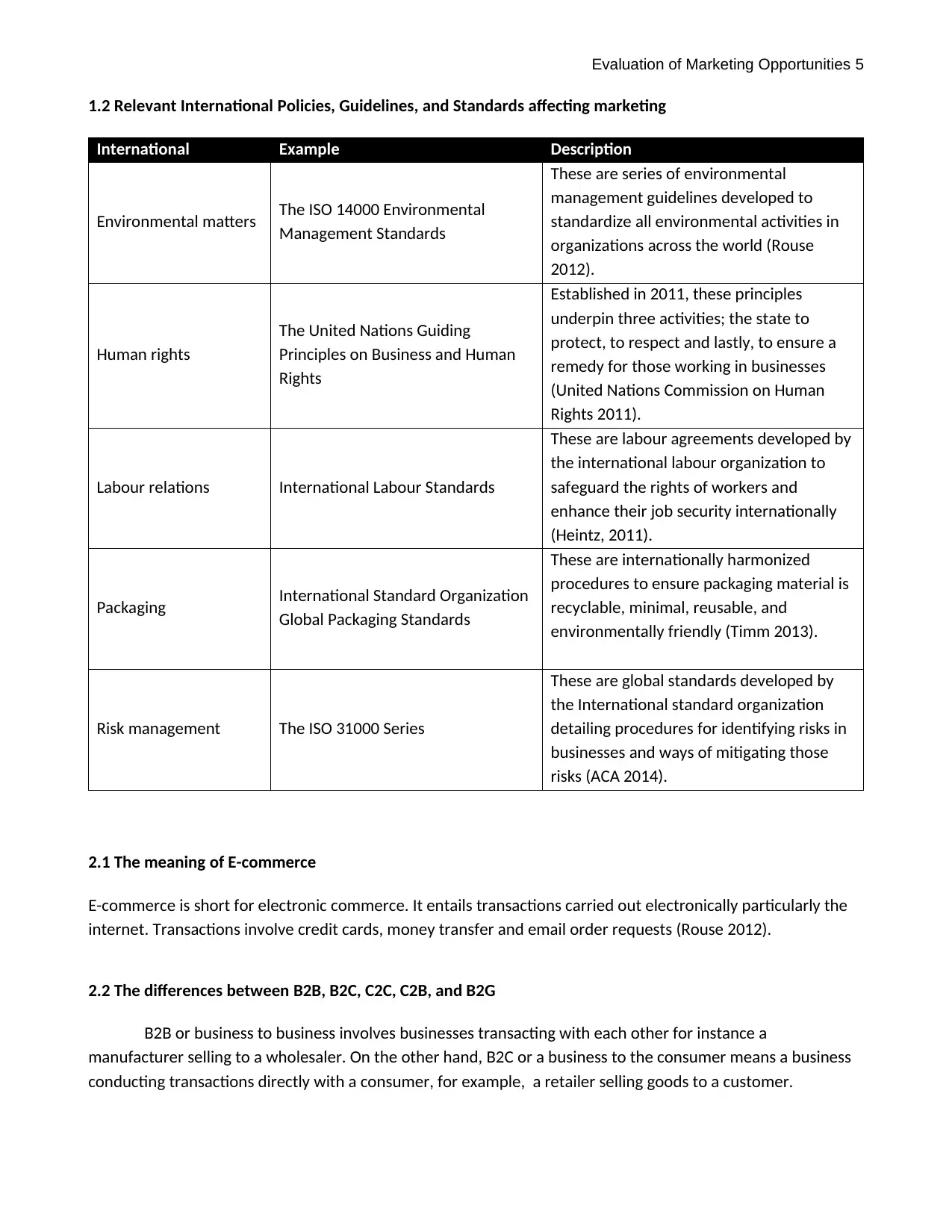
Evaluation of Marketing Opportunities 5
1.2 Relevant International Policies, Guidelines, and Standards affecting marketing
International Example Description
Environmental matters The ISO 14000 Environmental
Management Standards
These are series of environmental
management guidelines developed to
standardize all environmental activities in
organizations across the world (Rouse
2012).
Human rights
The United Nations Guiding
Principles on Business and Human
Rights
Established in 2011, these principles
underpin three activities; the state to
protect, to respect and lastly, to ensure a
remedy for those working in businesses
(United Nations Commission on Human
Rights 2011).
Labour relations International Labour Standards
These are labour agreements developed by
the international labour organization to
safeguard the rights of workers and
enhance their job security internationally
(Heintz, 2011).
Packaging International Standard Organization
Global Packaging Standards
These are internationally harmonized
procedures to ensure packaging material is
recyclable, minimal, reusable, and
environmentally friendly (Timm 2013).
Risk management The ISO 31000 Series
These are global standards developed by
the International standard organization
detailing procedures for identifying risks in
businesses and ways of mitigating those
risks (ACA 2014).
2.1 The meaning of E-commerce
E-commerce is short for electronic commerce. It entails transactions carried out electronically particularly the
internet. Transactions involve credit cards, money transfer and email order requests (Rouse 2012).
2.2 The differences between B2B, B2C, C2C, C2B, and B2G
B2B or business to business involves businesses transacting with each other for instance a
manufacturer selling to a wholesaler. On the other hand, B2C or a business to the consumer means a business
conducting transactions directly with a consumer, for example, a retailer selling goods to a customer.
1.2 Relevant International Policies, Guidelines, and Standards affecting marketing
International Example Description
Environmental matters The ISO 14000 Environmental
Management Standards
These are series of environmental
management guidelines developed to
standardize all environmental activities in
organizations across the world (Rouse
2012).
Human rights
The United Nations Guiding
Principles on Business and Human
Rights
Established in 2011, these principles
underpin three activities; the state to
protect, to respect and lastly, to ensure a
remedy for those working in businesses
(United Nations Commission on Human
Rights 2011).
Labour relations International Labour Standards
These are labour agreements developed by
the international labour organization to
safeguard the rights of workers and
enhance their job security internationally
(Heintz, 2011).
Packaging International Standard Organization
Global Packaging Standards
These are internationally harmonized
procedures to ensure packaging material is
recyclable, minimal, reusable, and
environmentally friendly (Timm 2013).
Risk management The ISO 31000 Series
These are global standards developed by
the International standard organization
detailing procedures for identifying risks in
businesses and ways of mitigating those
risks (ACA 2014).
2.1 The meaning of E-commerce
E-commerce is short for electronic commerce. It entails transactions carried out electronically particularly the
internet. Transactions involve credit cards, money transfer and email order requests (Rouse 2012).
2.2 The differences between B2B, B2C, C2C, C2B, and B2G
B2B or business to business involves businesses transacting with each other for instance a
manufacturer selling to a wholesaler. On the other hand, B2C or a business to the consumer means a business
conducting transactions directly with a consumer, for example, a retailer selling goods to a customer.
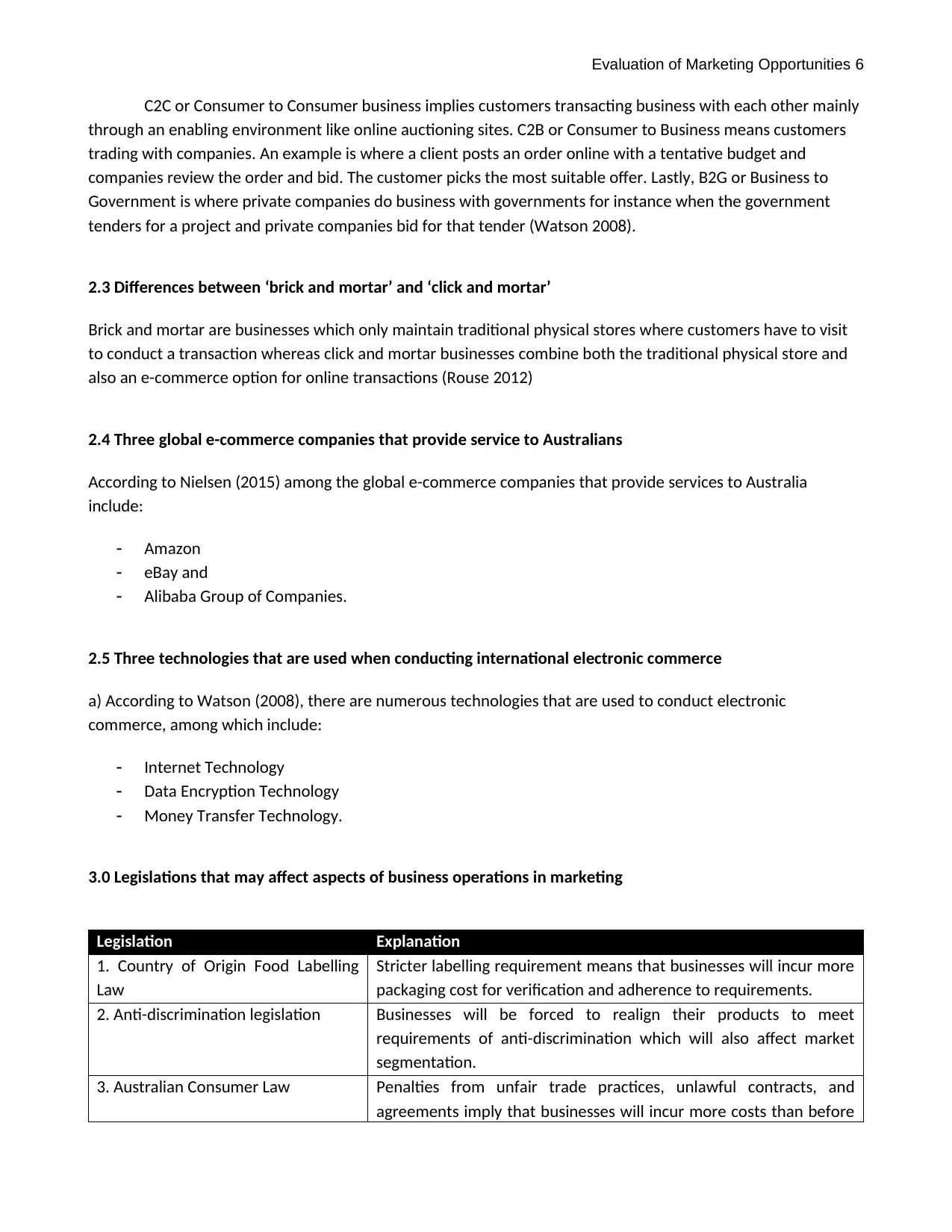
Evaluation of Marketing Opportunities 6
C2C or Consumer to Consumer business implies customers transacting business with each other mainly
through an enabling environment like online auctioning sites. C2B or Consumer to Business means customers
trading with companies. An example is where a client posts an order online with a tentative budget and
companies review the order and bid. The customer picks the most suitable offer. Lastly, B2G or Business to
Government is where private companies do business with governments for instance when the government
tenders for a project and private companies bid for that tender (Watson 2008).
2.3 Differences between ‘brick and mortar’ and ‘click and mortar’
Brick and mortar are businesses which only maintain traditional physical stores where customers have to visit
to conduct a transaction whereas click and mortar businesses combine both the traditional physical store and
also an e-commerce option for online transactions (Rouse 2012)
2.4 Three global e-commerce companies that provide service to Australians
According to Nielsen (2015) among the global e-commerce companies that provide services to Australia
include:
Amazon
eBay and
Alibaba Group of Companies.
2.5 Three technologies that are used when conducting international electronic commerce
a) According to Watson (2008), there are numerous technologies that are used to conduct electronic
commerce, among which include:
Internet Technology
Data Encryption Technology
Money Transfer Technology.
3.0 Legislations that may affect aspects of business operations in marketing
Legislation Explanation
1. Country of Origin Food Labelling
Law
Stricter labelling requirement means that businesses will incur more
packaging cost for verification and adherence to requirements.
2. Anti-discrimination legislation Businesses will be forced to realign their products to meet
requirements of anti-discrimination which will also affect market
segmentation.
3. Australian Consumer Law Penalties from unfair trade practices, unlawful contracts, and
agreements imply that businesses will incur more costs than before
C2C or Consumer to Consumer business implies customers transacting business with each other mainly
through an enabling environment like online auctioning sites. C2B or Consumer to Business means customers
trading with companies. An example is where a client posts an order online with a tentative budget and
companies review the order and bid. The customer picks the most suitable offer. Lastly, B2G or Business to
Government is where private companies do business with governments for instance when the government
tenders for a project and private companies bid for that tender (Watson 2008).
2.3 Differences between ‘brick and mortar’ and ‘click and mortar’
Brick and mortar are businesses which only maintain traditional physical stores where customers have to visit
to conduct a transaction whereas click and mortar businesses combine both the traditional physical store and
also an e-commerce option for online transactions (Rouse 2012)
2.4 Three global e-commerce companies that provide service to Australians
According to Nielsen (2015) among the global e-commerce companies that provide services to Australia
include:
Amazon
eBay and
Alibaba Group of Companies.
2.5 Three technologies that are used when conducting international electronic commerce
a) According to Watson (2008), there are numerous technologies that are used to conduct electronic
commerce, among which include:
Internet Technology
Data Encryption Technology
Money Transfer Technology.
3.0 Legislations that may affect aspects of business operations in marketing
Legislation Explanation
1. Country of Origin Food Labelling
Law
Stricter labelling requirement means that businesses will incur more
packaging cost for verification and adherence to requirements.
2. Anti-discrimination legislation Businesses will be forced to realign their products to meet
requirements of anti-discrimination which will also affect market
segmentation.
3. Australian Consumer Law Penalties from unfair trade practices, unlawful contracts, and
agreements imply that businesses will incur more costs than before
⊘ This is a preview!⊘
Do you want full access?
Subscribe today to unlock all pages.

Trusted by 1+ million students worldwide
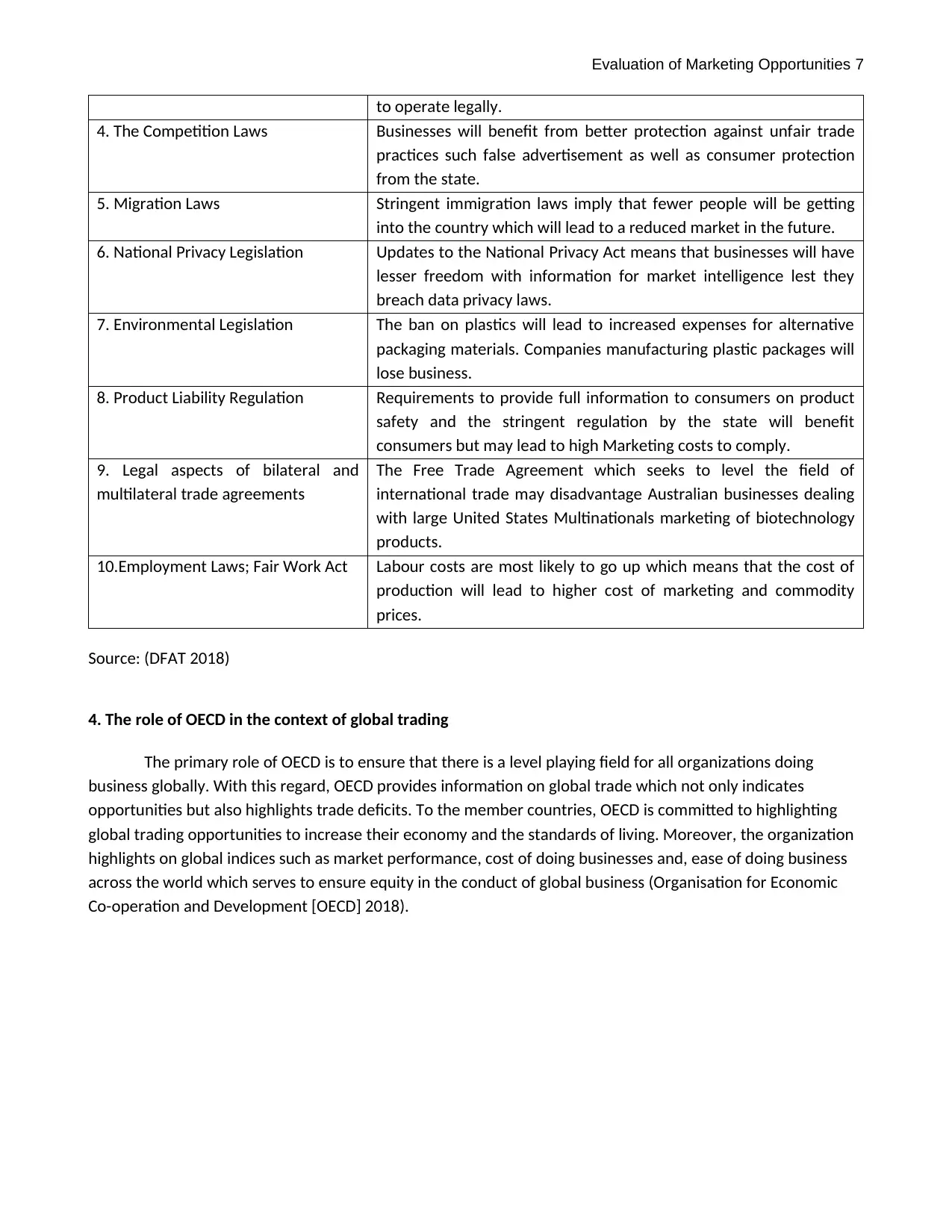
Evaluation of Marketing Opportunities 7
to operate legally.
4. The Competition Laws Businesses will benefit from better protection against unfair trade
practices such false advertisement as well as consumer protection
from the state.
5. Migration Laws Stringent immigration laws imply that fewer people will be getting
into the country which will lead to a reduced market in the future.
6. National Privacy Legislation Updates to the National Privacy Act means that businesses will have
lesser freedom with information for market intelligence lest they
breach data privacy laws.
7. Environmental Legislation The ban on plastics will lead to increased expenses for alternative
packaging materials. Companies manufacturing plastic packages will
lose business.
8. Product Liability Regulation Requirements to provide full information to consumers on product
safety and the stringent regulation by the state will benefit
consumers but may lead to high Marketing costs to comply.
9. Legal aspects of bilateral and
multilateral trade agreements
The Free Trade Agreement which seeks to level the field of
international trade may disadvantage Australian businesses dealing
with large United States Multinationals marketing of biotechnology
products.
10.Employment Laws; Fair Work Act Labour costs are most likely to go up which means that the cost of
production will lead to higher cost of marketing and commodity
prices.
Source: (DFAT 2018)
4. The role of OECD in the context of global trading
The primary role of OECD is to ensure that there is a level playing field for all organizations doing
business globally. With this regard, OECD provides information on global trade which not only indicates
opportunities but also highlights trade deficits. To the member countries, OECD is committed to highlighting
global trading opportunities to increase their economy and the standards of living. Moreover, the organization
highlights on global indices such as market performance, cost of doing businesses and, ease of doing business
across the world which serves to ensure equity in the conduct of global business (Organisation for Economic
Co-operation and Development [OECD] 2018).
to operate legally.
4. The Competition Laws Businesses will benefit from better protection against unfair trade
practices such false advertisement as well as consumer protection
from the state.
5. Migration Laws Stringent immigration laws imply that fewer people will be getting
into the country which will lead to a reduced market in the future.
6. National Privacy Legislation Updates to the National Privacy Act means that businesses will have
lesser freedom with information for market intelligence lest they
breach data privacy laws.
7. Environmental Legislation The ban on plastics will lead to increased expenses for alternative
packaging materials. Companies manufacturing plastic packages will
lose business.
8. Product Liability Regulation Requirements to provide full information to consumers on product
safety and the stringent regulation by the state will benefit
consumers but may lead to high Marketing costs to comply.
9. Legal aspects of bilateral and
multilateral trade agreements
The Free Trade Agreement which seeks to level the field of
international trade may disadvantage Australian businesses dealing
with large United States Multinationals marketing of biotechnology
products.
10.Employment Laws; Fair Work Act Labour costs are most likely to go up which means that the cost of
production will lead to higher cost of marketing and commodity
prices.
Source: (DFAT 2018)
4. The role of OECD in the context of global trading
The primary role of OECD is to ensure that there is a level playing field for all organizations doing
business globally. With this regard, OECD provides information on global trade which not only indicates
opportunities but also highlights trade deficits. To the member countries, OECD is committed to highlighting
global trading opportunities to increase their economy and the standards of living. Moreover, the organization
highlights on global indices such as market performance, cost of doing businesses and, ease of doing business
across the world which serves to ensure equity in the conduct of global business (Organisation for Economic
Co-operation and Development [OECD] 2018).
Paraphrase This Document
Need a fresh take? Get an instant paraphrase of this document with our AI Paraphraser
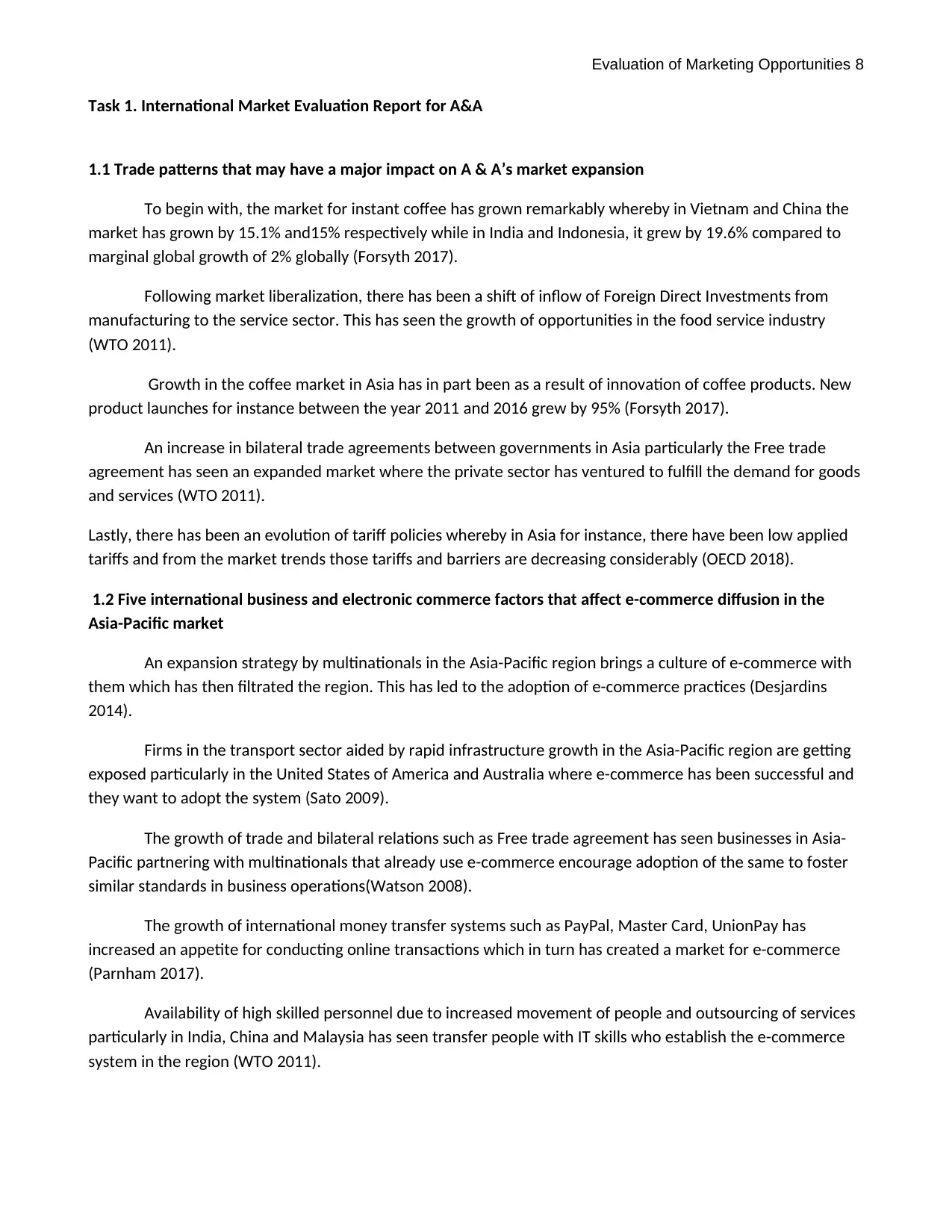
Evaluation of Marketing Opportunities 8
Task 1. International Market Evaluation Report for A&A
1.1 Trade patterns that may have a major impact on A & A’s market expansion
To begin with, the market for instant coffee has grown remarkably whereby in Vietnam and China the
market has grown by 15.1% and15% respectively while in India and Indonesia, it grew by 19.6% compared to
marginal global growth of 2% globally (Forsyth 2017).
Following market liberalization, there has been a shift of inflow of Foreign Direct Investments from
manufacturing to the service sector. This has seen the growth of opportunities in the food service industry
(WTO 2011).
Growth in the coffee market in Asia has in part been as a result of innovation of coffee products. New
product launches for instance between the year 2011 and 2016 grew by 95% (Forsyth 2017).
An increase in bilateral trade agreements between governments in Asia particularly the Free trade
agreement has seen an expanded market where the private sector has ventured to fulfill the demand for goods
and services (WTO 2011).
Lastly, there has been an evolution of tariff policies whereby in Asia for instance, there have been low applied
tariffs and from the market trends those tariffs and barriers are decreasing considerably (OECD 2018).
1.2 Five international business and electronic commerce factors that affect e-commerce diffusion in the
Asia-Pacific market
An expansion strategy by multinationals in the Asia-Pacific region brings a culture of e-commerce with
them which has then filtrated the region. This has led to the adoption of e-commerce practices (Desjardins
2014).
Firms in the transport sector aided by rapid infrastructure growth in the Asia-Pacific region are getting
exposed particularly in the United States of America and Australia where e-commerce has been successful and
they want to adopt the system (Sato 2009).
The growth of trade and bilateral relations such as Free trade agreement has seen businesses in Asia-
Pacific partnering with multinationals that already use e-commerce encourage adoption of the same to foster
similar standards in business operations(Watson 2008).
The growth of international money transfer systems such as PayPal, Master Card, UnionPay has
increased an appetite for conducting online transactions which in turn has created a market for e-commerce
(Parnham 2017).
Availability of high skilled personnel due to increased movement of people and outsourcing of services
particularly in India, China and Malaysia has seen transfer people with IT skills who establish the e-commerce
system in the region (WTO 2011).
Task 1. International Market Evaluation Report for A&A
1.1 Trade patterns that may have a major impact on A & A’s market expansion
To begin with, the market for instant coffee has grown remarkably whereby in Vietnam and China the
market has grown by 15.1% and15% respectively while in India and Indonesia, it grew by 19.6% compared to
marginal global growth of 2% globally (Forsyth 2017).
Following market liberalization, there has been a shift of inflow of Foreign Direct Investments from
manufacturing to the service sector. This has seen the growth of opportunities in the food service industry
(WTO 2011).
Growth in the coffee market in Asia has in part been as a result of innovation of coffee products. New
product launches for instance between the year 2011 and 2016 grew by 95% (Forsyth 2017).
An increase in bilateral trade agreements between governments in Asia particularly the Free trade
agreement has seen an expanded market where the private sector has ventured to fulfill the demand for goods
and services (WTO 2011).
Lastly, there has been an evolution of tariff policies whereby in Asia for instance, there have been low applied
tariffs and from the market trends those tariffs and barriers are decreasing considerably (OECD 2018).
1.2 Five international business and electronic commerce factors that affect e-commerce diffusion in the
Asia-Pacific market
An expansion strategy by multinationals in the Asia-Pacific region brings a culture of e-commerce with
them which has then filtrated the region. This has led to the adoption of e-commerce practices (Desjardins
2014).
Firms in the transport sector aided by rapid infrastructure growth in the Asia-Pacific region are getting
exposed particularly in the United States of America and Australia where e-commerce has been successful and
they want to adopt the system (Sato 2009).
The growth of trade and bilateral relations such as Free trade agreement has seen businesses in Asia-
Pacific partnering with multinationals that already use e-commerce encourage adoption of the same to foster
similar standards in business operations(Watson 2008).
The growth of international money transfer systems such as PayPal, Master Card, UnionPay has
increased an appetite for conducting online transactions which in turn has created a market for e-commerce
(Parnham 2017).
Availability of high skilled personnel due to increased movement of people and outsourcing of services
particularly in India, China and Malaysia has seen transfer people with IT skills who establish the e-commerce
system in the region (WTO 2011).
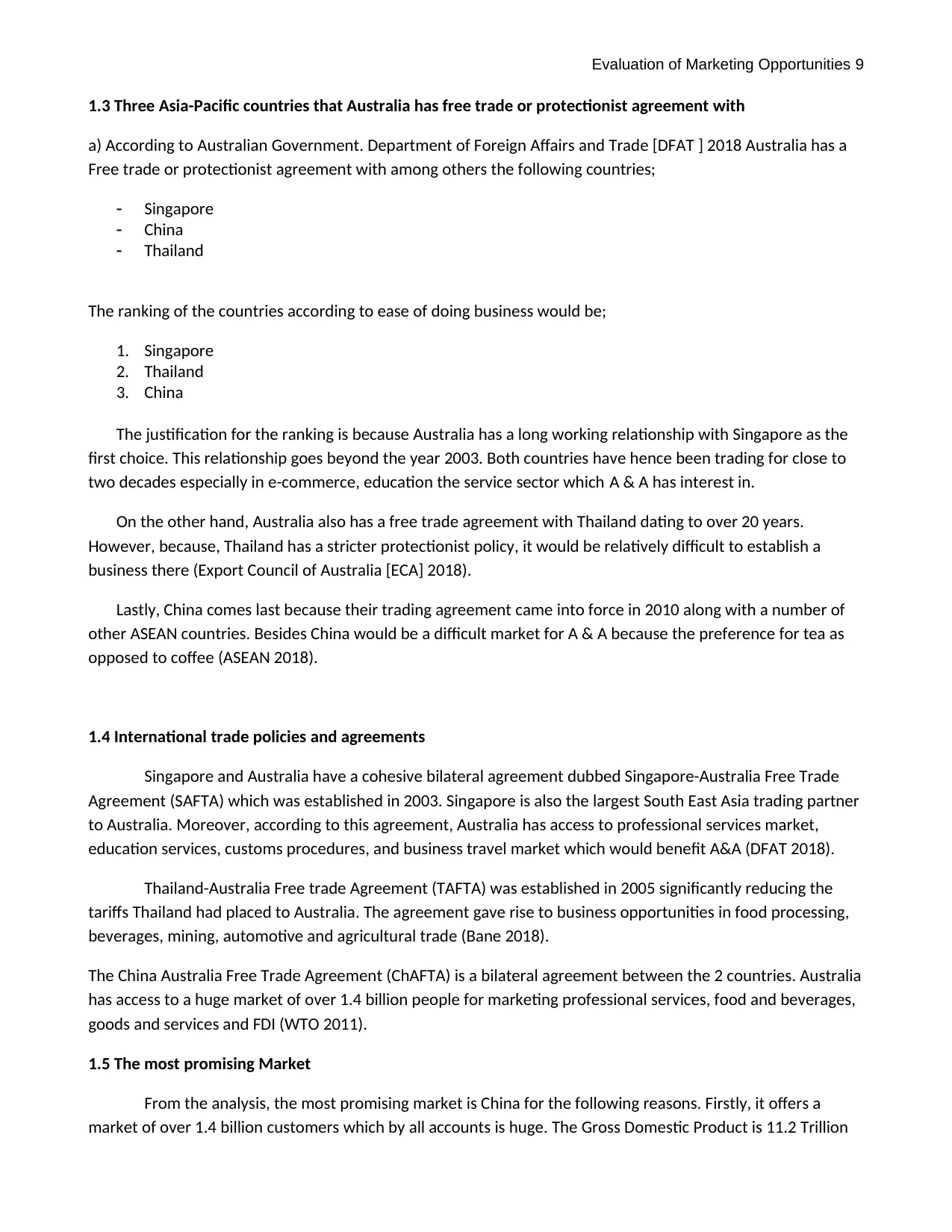
Evaluation of Marketing Opportunities 9
1.3 Three Asia-Pacific countries that Australia has free trade or protectionist agreement with
a) According to Australian Government. Department of Foreign Affairs and Trade [DFAT ] 2018 Australia has a
Free trade or protectionist agreement with among others the following countries;
Singapore
China
Thailand
The ranking of the countries according to ease of doing business would be;
1. Singapore
2. Thailand
3. China
The justification for the ranking is because Australia has a long working relationship with Singapore as the
first choice. This relationship goes beyond the year 2003. Both countries have hence been trading for close to
two decades especially in e-commerce, education the service sector which A & A has interest in.
On the other hand, Australia also has a free trade agreement with Thailand dating to over 20 years.
However, because, Thailand has a stricter protectionist policy, it would be relatively difficult to establish a
business there (Export Council of Australia [ECA] 2018).
Lastly, China comes last because their trading agreement came into force in 2010 along with a number of
other ASEAN countries. Besides China would be a difficult market for A & A because the preference for tea as
opposed to coffee (ASEAN 2018).
1.4 International trade policies and agreements
Singapore and Australia have a cohesive bilateral agreement dubbed Singapore-Australia Free Trade
Agreement (SAFTA) which was established in 2003. Singapore is also the largest South East Asia trading partner
to Australia. Moreover, according to this agreement, Australia has access to professional services market,
education services, customs procedures, and business travel market which would benefit A&A (DFAT 2018).
Thailand-Australia Free trade Agreement (TAFTA) was established in 2005 significantly reducing the
tariffs Thailand had placed to Australia. The agreement gave rise to business opportunities in food processing,
beverages, mining, automotive and agricultural trade (Bane 2018).
The China Australia Free Trade Agreement (ChAFTA) is a bilateral agreement between the 2 countries. Australia
has access to a huge market of over 1.4 billion people for marketing professional services, food and beverages,
goods and services and FDI (WTO 2011).
1.5 The most promising Market
From the analysis, the most promising market is China for the following reasons. Firstly, it offers a
market of over 1.4 billion customers which by all accounts is huge. The Gross Domestic Product is 11.2 Trillion
1.3 Three Asia-Pacific countries that Australia has free trade or protectionist agreement with
a) According to Australian Government. Department of Foreign Affairs and Trade [DFAT ] 2018 Australia has a
Free trade or protectionist agreement with among others the following countries;
Singapore
China
Thailand
The ranking of the countries according to ease of doing business would be;
1. Singapore
2. Thailand
3. China
The justification for the ranking is because Australia has a long working relationship with Singapore as the
first choice. This relationship goes beyond the year 2003. Both countries have hence been trading for close to
two decades especially in e-commerce, education the service sector which A & A has interest in.
On the other hand, Australia also has a free trade agreement with Thailand dating to over 20 years.
However, because, Thailand has a stricter protectionist policy, it would be relatively difficult to establish a
business there (Export Council of Australia [ECA] 2018).
Lastly, China comes last because their trading agreement came into force in 2010 along with a number of
other ASEAN countries. Besides China would be a difficult market for A & A because the preference for tea as
opposed to coffee (ASEAN 2018).
1.4 International trade policies and agreements
Singapore and Australia have a cohesive bilateral agreement dubbed Singapore-Australia Free Trade
Agreement (SAFTA) which was established in 2003. Singapore is also the largest South East Asia trading partner
to Australia. Moreover, according to this agreement, Australia has access to professional services market,
education services, customs procedures, and business travel market which would benefit A&A (DFAT 2018).
Thailand-Australia Free trade Agreement (TAFTA) was established in 2005 significantly reducing the
tariffs Thailand had placed to Australia. The agreement gave rise to business opportunities in food processing,
beverages, mining, automotive and agricultural trade (Bane 2018).
The China Australia Free Trade Agreement (ChAFTA) is a bilateral agreement between the 2 countries. Australia
has access to a huge market of over 1.4 billion people for marketing professional services, food and beverages,
goods and services and FDI (WTO 2011).
1.5 The most promising Market
From the analysis, the most promising market is China for the following reasons. Firstly, it offers a
market of over 1.4 billion customers which by all accounts is huge. The Gross Domestic Product is 11.2 Trillion
⊘ This is a preview!⊘
Do you want full access?
Subscribe today to unlock all pages.

Trusted by 1+ million students worldwide
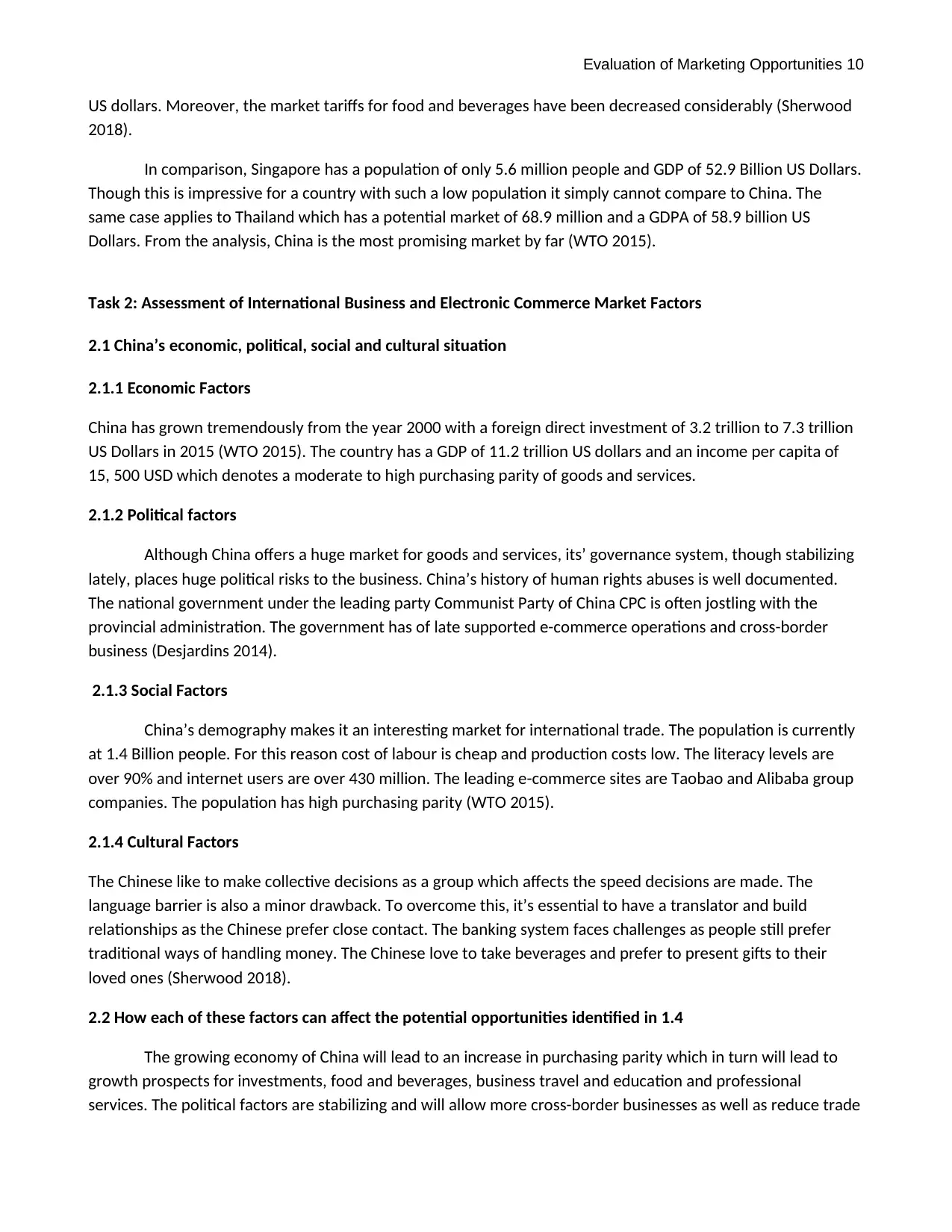
Evaluation of Marketing Opportunities 10
US dollars. Moreover, the market tariffs for food and beverages have been decreased considerably (Sherwood
2018).
In comparison, Singapore has a population of only 5.6 million people and GDP of 52.9 Billion US Dollars.
Though this is impressive for a country with such a low population it simply cannot compare to China. The
same case applies to Thailand which has a potential market of 68.9 million and a GDPA of 58.9 billion US
Dollars. From the analysis, China is the most promising market by far (WTO 2015).
Task 2: Assessment of International Business and Electronic Commerce Market Factors
2.1 China’s economic, political, social and cultural situation
2.1.1 Economic Factors
China has grown tremendously from the year 2000 with a foreign direct investment of 3.2 trillion to 7.3 trillion
US Dollars in 2015 (WTO 2015). The country has a GDP of 11.2 trillion US dollars and an income per capita of
15, 500 USD which denotes a moderate to high purchasing parity of goods and services.
2.1.2 Political factors
Although China offers a huge market for goods and services, its’ governance system, though stabilizing
lately, places huge political risks to the business. China’s history of human rights abuses is well documented.
The national government under the leading party Communist Party of China CPC is often jostling with the
provincial administration. The government has of late supported e-commerce operations and cross-border
business (Desjardins 2014).
2.1.3 Social Factors
China’s demography makes it an interesting market for international trade. The population is currently
at 1.4 Billion people. For this reason cost of labour is cheap and production costs low. The literacy levels are
over 90% and internet users are over 430 million. The leading e-commerce sites are Taobao and Alibaba group
companies. The population has high purchasing parity (WTO 2015).
2.1.4 Cultural Factors
The Chinese like to make collective decisions as a group which affects the speed decisions are made. The
language barrier is also a minor drawback. To overcome this, it’s essential to have a translator and build
relationships as the Chinese prefer close contact. The banking system faces challenges as people still prefer
traditional ways of handling money. The Chinese love to take beverages and prefer to present gifts to their
loved ones (Sherwood 2018).
2.2 How each of these factors can affect the potential opportunities identified in 1.4
The growing economy of China will lead to an increase in purchasing parity which in turn will lead to
growth prospects for investments, food and beverages, business travel and education and professional
services. The political factors are stabilizing and will allow more cross-border businesses as well as reduce trade
US dollars. Moreover, the market tariffs for food and beverages have been decreased considerably (Sherwood
2018).
In comparison, Singapore has a population of only 5.6 million people and GDP of 52.9 Billion US Dollars.
Though this is impressive for a country with such a low population it simply cannot compare to China. The
same case applies to Thailand which has a potential market of 68.9 million and a GDPA of 58.9 billion US
Dollars. From the analysis, China is the most promising market by far (WTO 2015).
Task 2: Assessment of International Business and Electronic Commerce Market Factors
2.1 China’s economic, political, social and cultural situation
2.1.1 Economic Factors
China has grown tremendously from the year 2000 with a foreign direct investment of 3.2 trillion to 7.3 trillion
US Dollars in 2015 (WTO 2015). The country has a GDP of 11.2 trillion US dollars and an income per capita of
15, 500 USD which denotes a moderate to high purchasing parity of goods and services.
2.1.2 Political factors
Although China offers a huge market for goods and services, its’ governance system, though stabilizing
lately, places huge political risks to the business. China’s history of human rights abuses is well documented.
The national government under the leading party Communist Party of China CPC is often jostling with the
provincial administration. The government has of late supported e-commerce operations and cross-border
business (Desjardins 2014).
2.1.3 Social Factors
China’s demography makes it an interesting market for international trade. The population is currently
at 1.4 Billion people. For this reason cost of labour is cheap and production costs low. The literacy levels are
over 90% and internet users are over 430 million. The leading e-commerce sites are Taobao and Alibaba group
companies. The population has high purchasing parity (WTO 2015).
2.1.4 Cultural Factors
The Chinese like to make collective decisions as a group which affects the speed decisions are made. The
language barrier is also a minor drawback. To overcome this, it’s essential to have a translator and build
relationships as the Chinese prefer close contact. The banking system faces challenges as people still prefer
traditional ways of handling money. The Chinese love to take beverages and prefer to present gifts to their
loved ones (Sherwood 2018).
2.2 How each of these factors can affect the potential opportunities identified in 1.4
The growing economy of China will lead to an increase in purchasing parity which in turn will lead to
growth prospects for investments, food and beverages, business travel and education and professional
services. The political factors are stabilizing and will allow more cross-border businesses as well as reduce trade
Paraphrase This Document
Need a fresh take? Get an instant paraphrase of this document with our AI Paraphraser
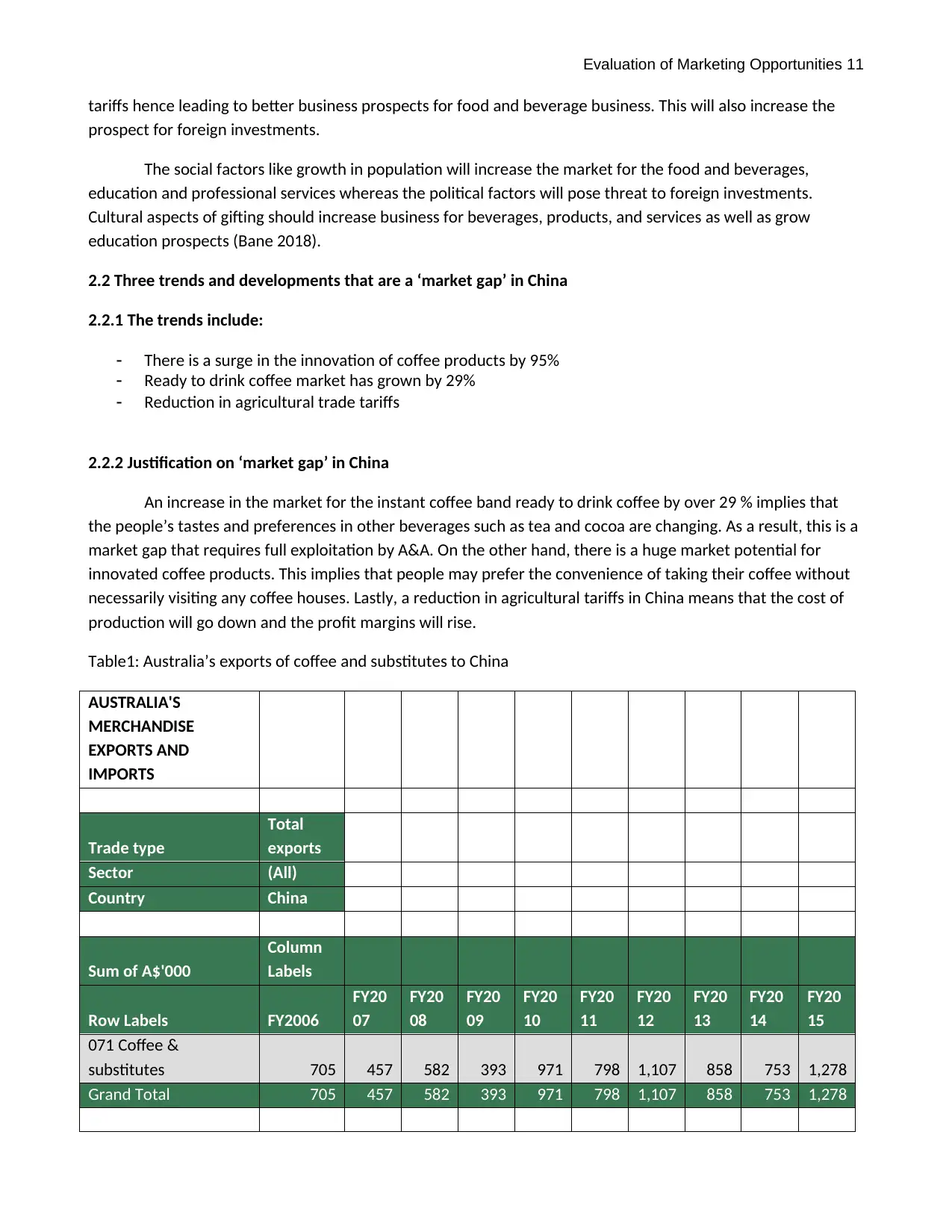
Evaluation of Marketing Opportunities 11
tariffs hence leading to better business prospects for food and beverage business. This will also increase the
prospect for foreign investments.
The social factors like growth in population will increase the market for the food and beverages,
education and professional services whereas the political factors will pose threat to foreign investments.
Cultural aspects of gifting should increase business for beverages, products, and services as well as grow
education prospects (Bane 2018).
2.2 Three trends and developments that are a ‘market gap’ in China
2.2.1 The trends include:
There is a surge in the innovation of coffee products by 95%
Ready to drink coffee market has grown by 29%
Reduction in agricultural trade tariffs
2.2.2 Justification on ‘market gap’ in China
An increase in the market for the instant coffee band ready to drink coffee by over 29 % implies that
the people’s tastes and preferences in other beverages such as tea and cocoa are changing. As a result, this is a
market gap that requires full exploitation by A&A. On the other hand, there is a huge market potential for
innovated coffee products. This implies that people may prefer the convenience of taking their coffee without
necessarily visiting any coffee houses. Lastly, a reduction in agricultural tariffs in China means that the cost of
production will go down and the profit margins will rise.
Table1: Australia’s exports of coffee and substitutes to China
AUSTRALIA'S
MERCHANDISE
EXPORTS AND
IMPORTS
Trade type
Total
exports
Sector (All)
Country China
Sum of A$'000
Column
Labels
Row Labels FY2006
FY20
07
FY20
08
FY20
09
FY20
10
FY20
11
FY20
12
FY20
13
FY20
14
FY20
15
071 Coffee &
substitutes 705 457 582 393 971 798 1,107 858 753 1,278
Grand Total 705 457 582 393 971 798 1,107 858 753 1,278
tariffs hence leading to better business prospects for food and beverage business. This will also increase the
prospect for foreign investments.
The social factors like growth in population will increase the market for the food and beverages,
education and professional services whereas the political factors will pose threat to foreign investments.
Cultural aspects of gifting should increase business for beverages, products, and services as well as grow
education prospects (Bane 2018).
2.2 Three trends and developments that are a ‘market gap’ in China
2.2.1 The trends include:
There is a surge in the innovation of coffee products by 95%
Ready to drink coffee market has grown by 29%
Reduction in agricultural trade tariffs
2.2.2 Justification on ‘market gap’ in China
An increase in the market for the instant coffee band ready to drink coffee by over 29 % implies that
the people’s tastes and preferences in other beverages such as tea and cocoa are changing. As a result, this is a
market gap that requires full exploitation by A&A. On the other hand, there is a huge market potential for
innovated coffee products. This implies that people may prefer the convenience of taking their coffee without
necessarily visiting any coffee houses. Lastly, a reduction in agricultural tariffs in China means that the cost of
production will go down and the profit margins will rise.
Table1: Australia’s exports of coffee and substitutes to China
AUSTRALIA'S
MERCHANDISE
EXPORTS AND
IMPORTS
Trade type
Total
exports
Sector (All)
Country China
Sum of A$'000
Column
Labels
Row Labels FY2006
FY20
07
FY20
08
FY20
09
FY20
10
FY20
11
FY20
12
FY20
13
FY20
14
FY20
15
071 Coffee &
substitutes 705 457 582 393 971 798 1,107 858 753 1,278
Grand Total 705 457 582 393 971 798 1,107 858 753 1,278
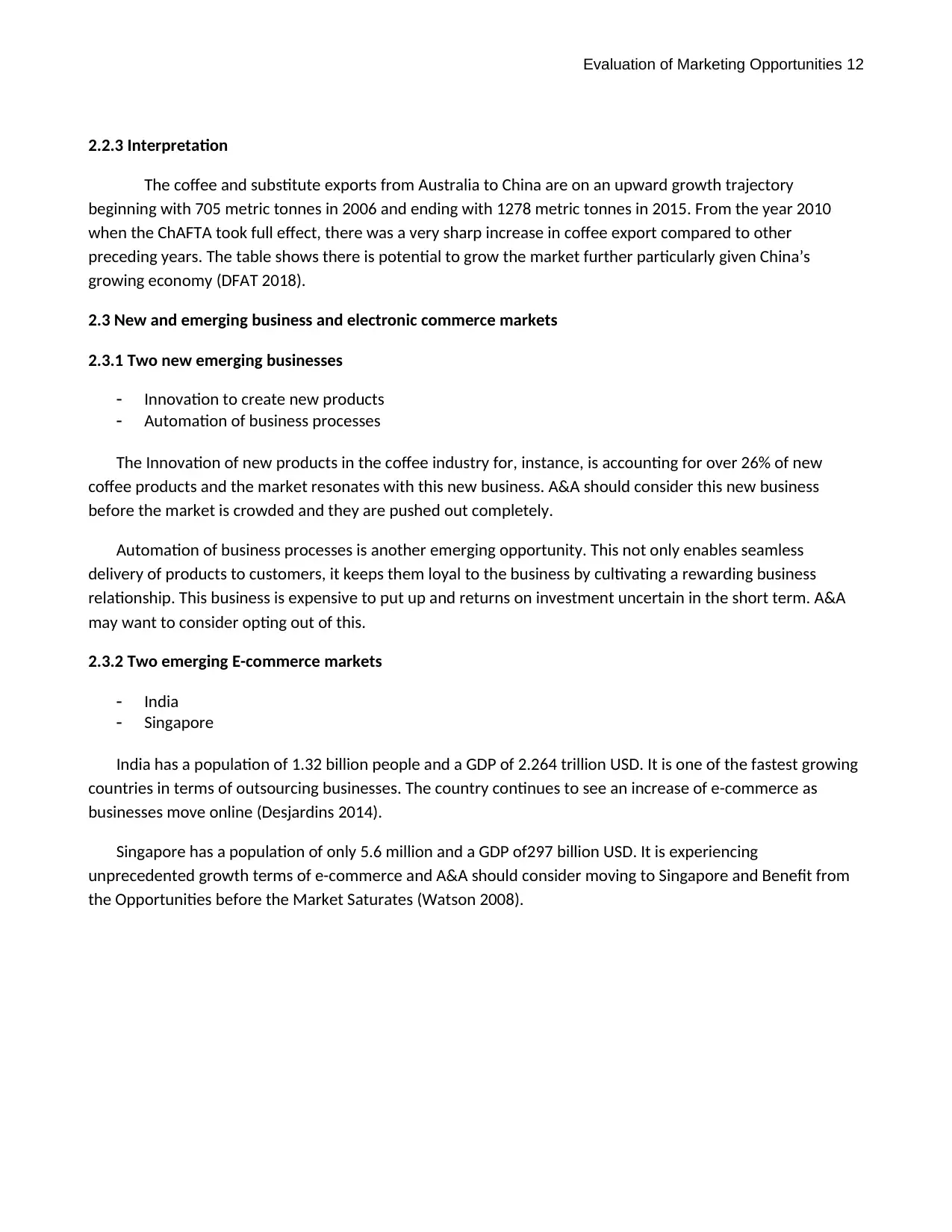
Evaluation of Marketing Opportunities 12
2.2.3 Interpretation
The coffee and substitute exports from Australia to China are on an upward growth trajectory
beginning with 705 metric tonnes in 2006 and ending with 1278 metric tonnes in 2015. From the year 2010
when the ChAFTA took full effect, there was a very sharp increase in coffee export compared to other
preceding years. The table shows there is potential to grow the market further particularly given China’s
growing economy (DFAT 2018).
2.3 New and emerging business and electronic commerce markets
2.3.1 Two new emerging businesses
Innovation to create new products
Automation of business processes
The Innovation of new products in the coffee industry for, instance, is accounting for over 26% of new
coffee products and the market resonates with this new business. A&A should consider this new business
before the market is crowded and they are pushed out completely.
Automation of business processes is another emerging opportunity. This not only enables seamless
delivery of products to customers, it keeps them loyal to the business by cultivating a rewarding business
relationship. This business is expensive to put up and returns on investment uncertain in the short term. A&A
may want to consider opting out of this.
2.3.2 Two emerging E-commerce markets
India
Singapore
India has a population of 1.32 billion people and a GDP of 2.264 trillion USD. It is one of the fastest growing
countries in terms of outsourcing businesses. The country continues to see an increase of e-commerce as
businesses move online (Desjardins 2014).
Singapore has a population of only 5.6 million and a GDP of297 billion USD. It is experiencing
unprecedented growth terms of e-commerce and A&A should consider moving to Singapore and Benefit from
the Opportunities before the Market Saturates (Watson 2008).
2.2.3 Interpretation
The coffee and substitute exports from Australia to China are on an upward growth trajectory
beginning with 705 metric tonnes in 2006 and ending with 1278 metric tonnes in 2015. From the year 2010
when the ChAFTA took full effect, there was a very sharp increase in coffee export compared to other
preceding years. The table shows there is potential to grow the market further particularly given China’s
growing economy (DFAT 2018).
2.3 New and emerging business and electronic commerce markets
2.3.1 Two new emerging businesses
Innovation to create new products
Automation of business processes
The Innovation of new products in the coffee industry for, instance, is accounting for over 26% of new
coffee products and the market resonates with this new business. A&A should consider this new business
before the market is crowded and they are pushed out completely.
Automation of business processes is another emerging opportunity. This not only enables seamless
delivery of products to customers, it keeps them loyal to the business by cultivating a rewarding business
relationship. This business is expensive to put up and returns on investment uncertain in the short term. A&A
may want to consider opting out of this.
2.3.2 Two emerging E-commerce markets
India
Singapore
India has a population of 1.32 billion people and a GDP of 2.264 trillion USD. It is one of the fastest growing
countries in terms of outsourcing businesses. The country continues to see an increase of e-commerce as
businesses move online (Desjardins 2014).
Singapore has a population of only 5.6 million and a GDP of297 billion USD. It is experiencing
unprecedented growth terms of e-commerce and A&A should consider moving to Singapore and Benefit from
the Opportunities before the Market Saturates (Watson 2008).
⊘ This is a preview!⊘
Do you want full access?
Subscribe today to unlock all pages.

Trusted by 1+ million students worldwide
1 out of 24
Related Documents
Your All-in-One AI-Powered Toolkit for Academic Success.
+13062052269
info@desklib.com
Available 24*7 on WhatsApp / Email
![[object Object]](/_next/static/media/star-bottom.7253800d.svg)
Unlock your academic potential
Copyright © 2020–2025 A2Z Services. All Rights Reserved. Developed and managed by ZUCOL.





